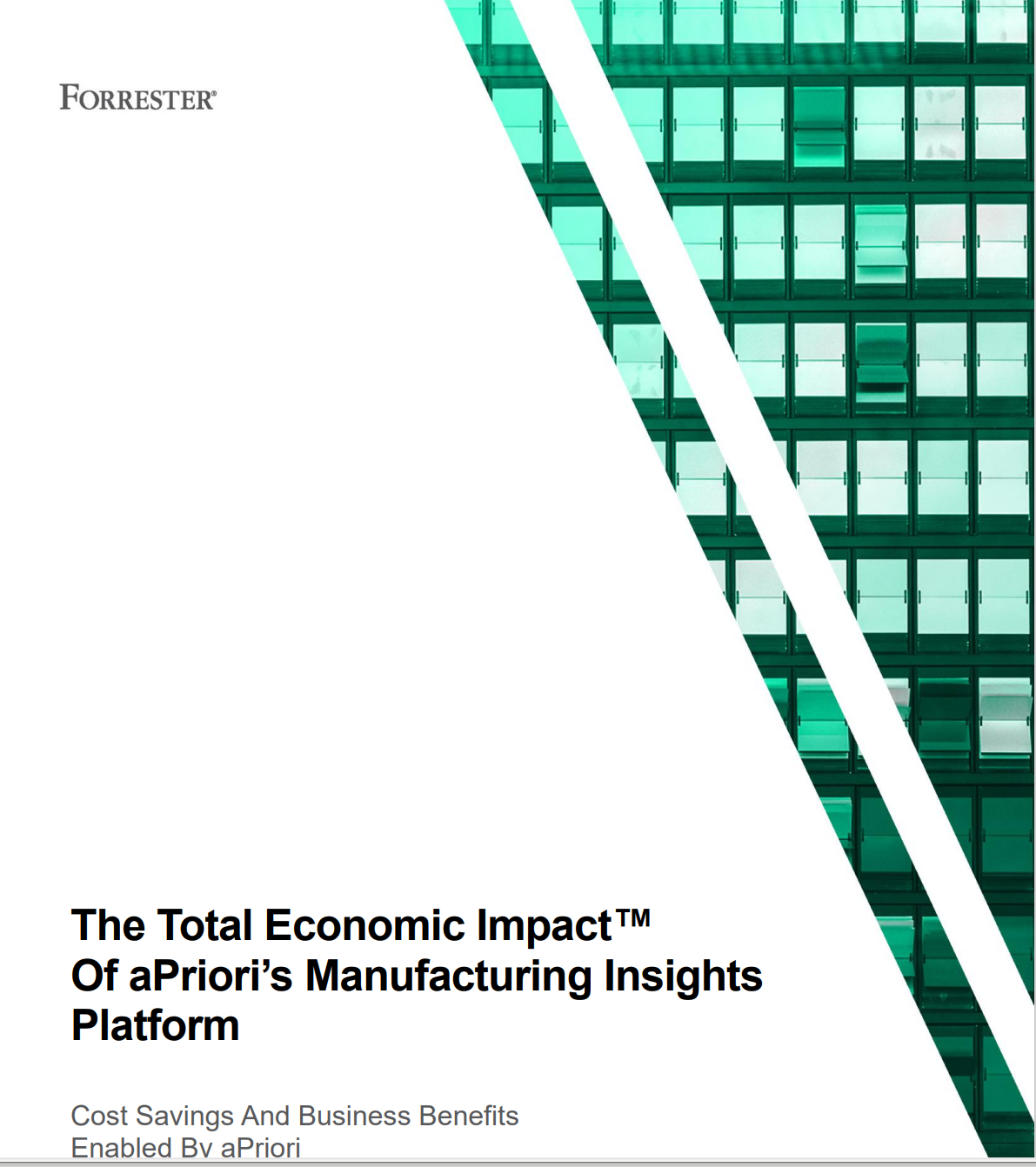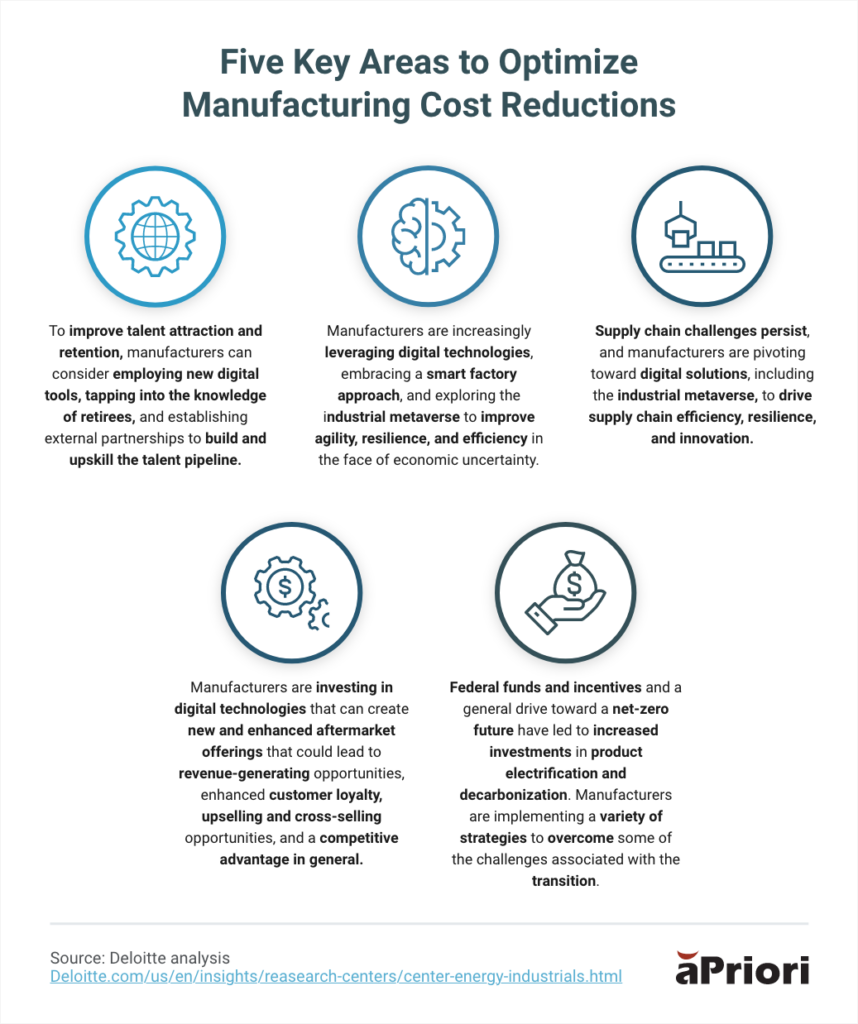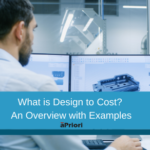
Key Takeaways:
- Well-intentioned strategies can sometimes stymie manufacturing cost reductions
- Leveraging digital manufacturing solutions can optimize costs and mitigate unintended consequences
The Full Article:
Deloitte’s 2024 Manufacturing Industry Outlook indicates that manufacturers continue to grapple with economic uncertainty, stemming from continued supply disruptions, skills shortages, and pressure to innovate while meeting internal net-zero emissions goals.
Although many organizations are well-intentioned, their approaches often stymie manufacturing cost reductions. Consider the following five approaches and their fixes:
Approach #1: Underutilize Costing Software
As growing competition threatens profit margins, a consumer products brand is responding by refocusing on profitability (lowering costs) and innovation. Initially, the company had a limited understanding of aPriori’s cost estimation software and didn’t always provide the pertinent data to fully optimize aPriori.
Fix: Identify precise issues and goals first, then optimize cost estimation software to achieve them. This includes:
- Rooting out cost-savings opportunities with supplier-specific digital factories for a clearer comparison and understanding of costs (e.g., price per part vs. total cost)
- Using the information from digital factory data to facilitate supplier discussions and better understand their calculation methods (e.g., manufacturing cost questions raised when you compared price per part against total cost)
- Leveraging fact-based, cost-driver comparison as a negotiation strategy
- Updating cost and supplier information regularly (e.g., tool shop rates, direct and indirect expenses, etc.) to improve your understanding of your suppliers’ cost models
Impact:
- Generate a defensible and granular cost model
- Enable a standardized, repeatable costing process for fact-based negotiations with suppliers
- Identify early cost drivers and streamline the estimation process
- Realize a nearly 10% savings on a critical part (the company continues to evaluate additional cost-saving opportunities)
Read our Guide to Manufacturing Cost Estimation.
Approach #2: Assume that Sustainability and Profitability Can’t Coexist
The carbon border adjustment mechanism (CBAM) could impact product pricing by as much as 30%. As a result, too many manufacturers don’t see a clear path to balancing sustainability and profitability.
Carrier has committed to reducing its customers’ carbon footprint by more than a gigaton by 2030. However, their suppliers were reluctant to share data integral to sustainability calculations.
Fix: Utilize a sustainable manufacturing solution with cost vs. carbon analysis to lower CO2e emissions and ensure profitability. This includes:
- Obtaining more manufacturability, carbon, and cost data for better product design, materials, and production decision-making
- Implementing a sustainable manufacturing solution with proactive, actionable insights to reduce the product’s carbon footprint
- Using the digital twin to optimize a product design, cost-effectiveness, and sustainability
Impact:
- Realize $21 million in annual savings
- Accelerate time to market with more sustainable innovations
- Analyze CO2e impacts
- Fast-track Environmental Product Declaration (EPD) certification by 33%
Learn more about how Carrier achieved tremendous savings while becoming more sustainable.
Approach #3: Overlook How Automation Can Offset Labor Shortages
A NAM Q4 2023 survey found that 89% of respondents said higher taxes on manufacturing activities would make it more difficult for them to hire additional workers, invest in new equipment and/or expand their facilities. More than 71.4% cited the inability to attract and retain employees as their primary challenge.
Woodward felt this labor pinch too. With a complex and massive global supply chain to manage, the company needed to strategize in anticipation of machinists (75% of whom are 45 or older in the U.S.) exiting the workforce while ensuring a competitive edge in the marketplace.
Fix: Recognize the value of automated quoting. This includes:
- Streamlining business processes via digital twins
- Using automation to help your workforce increase productivity
- Identifying sourcing in emerging countries with regional data libraries
- Focusing digital factory insights on high-cost drivers and pricing of thousands of components simultaneously
- Simulating suppliers’ capabilities, capacity, and cost structure via digital factories to help establish accurate “should cost” models
Impact:
- Improve supplier collaboration and fact-based negotiations to reduce labor costs and improve competitive position
- Decrease quoting iterations and timeline from 10 weeks down to one week
- In one instance, a supplier reallocated 80% of its quoting team back to the factory floor – without sacrificing quote response times
Delve deeper into how greater supplier collaboration addressed Woodward’s labor challenges.
Approach #4: Accept the “We’ve Always Done it This Way” Reasoning
A recent Deloitte article notes that 76% of manufacturers are adopting digital tools to gain enhanced transparency in their supply chain. Alstom is applying manufacturing technology to accelerate its sourcing operations.
Alstom cost models diverse and voluminous components. Consequently, each RFQ was vulnerable to delays. Suppliers took up to three weeks to return a quote. Rushed RFQ processes limited Alstom’s flexibility in garnering multiple quotes for maximized savings. This time crunch often forced them to simply accept the first bid returned.
Fix: Invest in mining accurate, current supplier data globally. This includes:
- Working from a central database across product development teams
- Streamlining processes including automating component procurement via a strategic supplier
- Using the digital twin to identify critical supply chain issues
- Creating “what if” scenarios to consider and mitigate
- Analyzing suppliers and sourcing strategies quickly, pinpointing those who can ensure supply chain continuity
Impact:
- Eliminate RFQ processing delays. Automatically send purchase orders directly to preferred, qualified suppliers
- Cost model more than 20,000 parts annually
- Save 40% of recurring supplier costs
- Strengthen supply chain management, supplier relationships, and data sharing
Discover how Alstom dramatically reduced its supplier costs.
Approach #5: Use Speed to Head Off Risk
KPMG reports that more than six out of 10 international organizations anticipate that geopolitical instability could have a detrimental impact on their supply chains within the next three years.
Flex manages over one million different parts (internally manufactured and purchased from over 16,000 global suppliers). The company was using various processes across the organization to manually quote, leading to delays and multiple RFQ iterations.
Fix: Utilize manufacturing insights to identify manufacturability, cost, sourcing, and sustainability outliers and issues early in design. This includes:
- Ditching the manual, spreadsheet for quoting in favor of digital factories
- Simulating manufacturing in a digital factory, configured to match each location’s unique capabilities, cost structure, regional differences in labor and energy costs, tooling capabilities, etc.
- Making cost models easy to tailor for new RFQs and to implement into customer-facing quotes
- Using early insights to mitigate issues, allowing for greater productivity, innovation, scalability, and time-to-market acceleration
Impact:
- Gain consistent, simulation-driven, and accurate global cost models and quotes
- Get more granular cost structure data for more informed decision-making and real-time sourcing alternative comparisons
- Reduce quoting times by a minimum of 35% and as much as 80% in some locations
- Decrease bill of materials (BOM) generation from three days to just 30 seconds
- Secure higher win rates (from 15% to 68%)
Explore how Flex accelerated quoting times and increased RFQ wins.
Actions Speak Louder Than Words…Just Ask Forrester
See for Yourself: 603% ROI, $19.7M NPV, 10% ↓ Procurement Spend, 70% ↑ Design Efficiency






